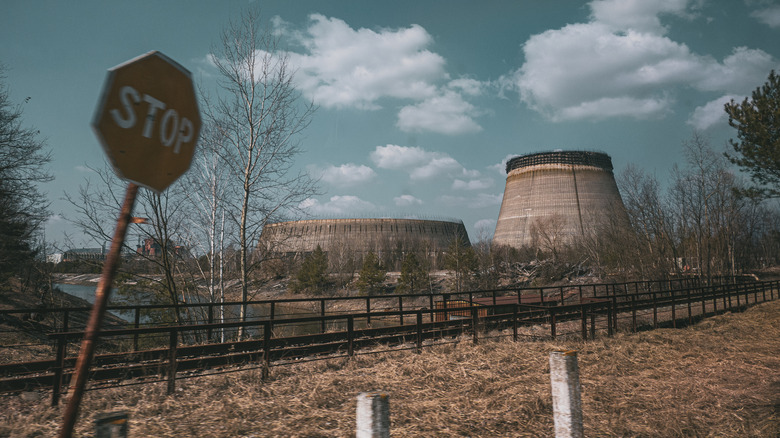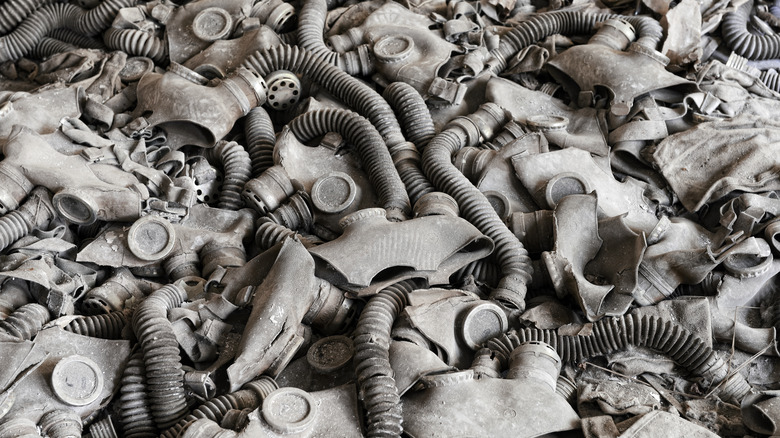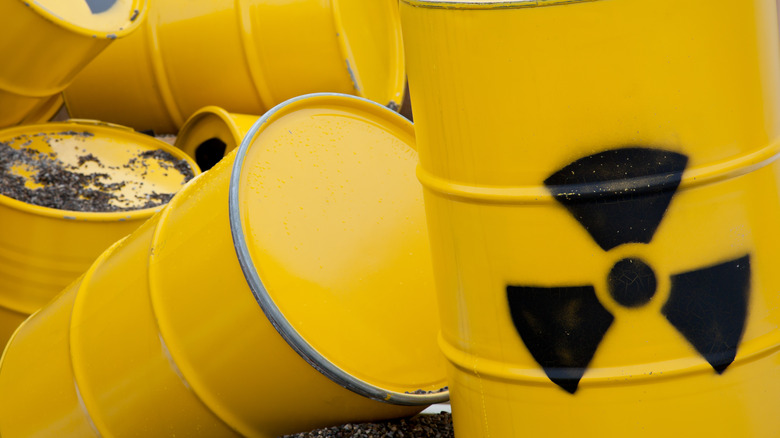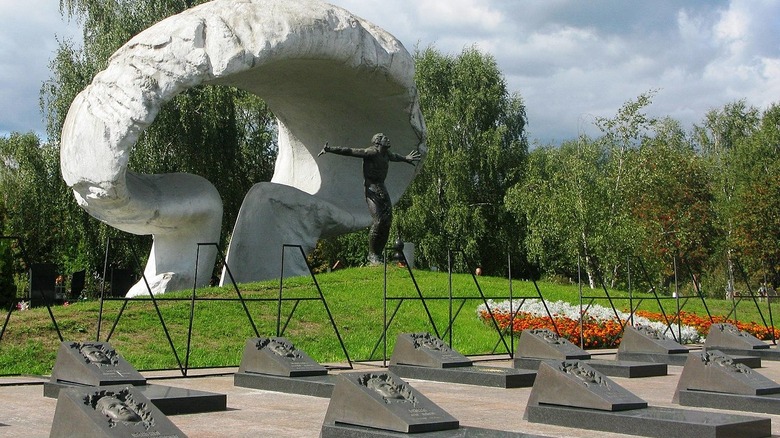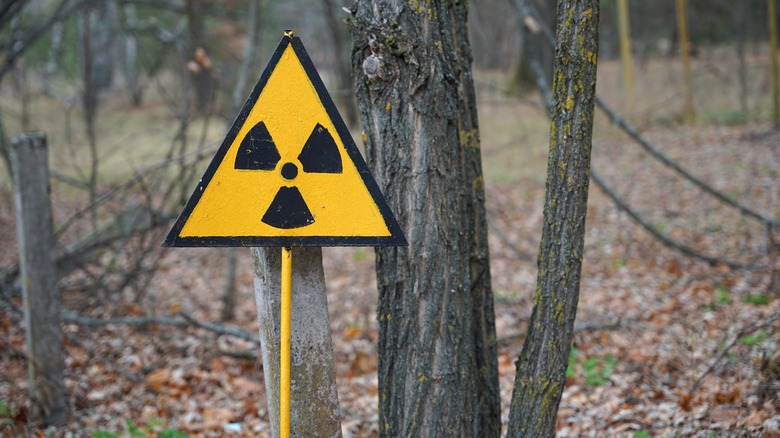What Happened To The Bodies Of Chernobyl Victims?
No matter how generally safe, nuclear energy gets much more attention for its disasters than its successes. In 2011, an earthquake off the coast of Japan sent a tsunami crashing into the nuclear power plant in Fukushima – its reactors were eventually stabilized but the plant is now off-line. Thankfully, not a single person died from the radiation sickness, no matter that over 100,000 nearby people were evacuated. Before Fukushima, the last nuclear disaster happened 25 years prior at Chernobyl in 1986.
Chernobyl is often cited as one of the worst, if not the worst, man-made disasters in history. Located in northern Ukraine — then a part of the Soviet Union — near the Belarusian border, its meltdown led to a host of upgraded nuclear power plant safety procedures and design improvements. Two people died in its initial reactor explosion, its reactor material spread as far as Sweden and Japan, and as of 2005 there were over 6,000 exposed people who developed thyroid cancer from radiation exposure from the blast. More than half-a-million recovery workers were also exposed to radiation.
But, its Chernobyl's first responders who were hit the worst. According to Unilad, 29 firefighters — those who responded to the initial reactor No. 4 explosion and fire — died within weeks from acute radiation exposure. That's 29 out of 186 total individuals, per Coffee or Die Magazine, a "military culture" publication. Along with engineer Vladimir Shashenok, these firefighters had to be buried in lead coffins to prevent their bodies from contaminating the environment. Engineer Valery Khodemchuk, meanwhile, was sealed with reactor No. 4 and has never been recovered.
The first 2 victims
The 1986 Chernobyl disaster claimed the life of engineer Valery Khodemchuk before anyone else. Khodemchuk and his co-worker Volodymyr Shashenok were on site working at the time of the initial explosion and running some tests. Khodemchuk went to reactor No. 4's engine room to check the test results, and that's when the reactor blew a monstrous fireball of nuclear material into the atmosphere. Khodemchuk's remains have never been recovered. For safety purposes, Soviet engineers built a massive concrete and steel shell around reactor No. 4, one that can't be opened.
Shashenok tried to rescue Khodemchuk, but couldn't. First responders found him on site, severely irradiated and burned from steam and water. "It was not my husband at all, it was a swollen blister," Shashenok's wife Lyudmila Shashenok said when she arrived at the hospital (per IOL via Associated Press). For his part, Shashenok kept muttering, "I turned off the voltage ... I did everything." He died five hours after being recovered.
Shashenok was buried two days later in a regular cemetery near Chernobyl. Lyudmilla didn't attend because everyone in the area had been evacuated and no one told her the time of the funeral. A year later his body was disinterred and moved to Mitinskoye Cemetery, where he was placed in a lead coffin and covered in concrete to protect the environment from his irradiated body.
First responders buried in lead casket
Flames from the initial Chernobyl explosion climbed to more than 3,600 degrees Fahrenheit, and firefighters on the scene were exposed to lethal doses of radiation. Lt. Volodymyr Pravyk and his squad of 13 firefighters were amongst those exposed to the worst of it. Radiation levels directly inside reactor No. 4 were so high that it would've taken a mere 48 seconds of exposure to seal someone's fate, per Coffee or Die. Pravyk and a team of five individuals — Vladimir Tishura, Nikolai Titenok, Vasily Ignatenko, Nikolai Vashchuck, and Viktor Kibenok — took to the roof to pour water down on the reactor. From there, they lasted an hour before their muscles began to fail them and they started retching, and they themselves wound up having to be rescued.
These men were only six of 29 firefighters who died in the performance of their job and duty. More and more firefighters kept showing up at Chernobyl, not really equipped for radiation exposure, but charged in anyway to douse the flames. The Guardian reported that Pravyk's brown eyes turned blue from such intense radiation exposure, while the autopsy of fellow firefighter Nikolai Titenok showed that he'd developed blisters on his heart. Even their gear was so radioactive that it was dumped in the basement of Pripyat hospital and can't be approached without a hazmat suit and filtered breathing apparatus. Like engineer Vladimir Shashenok, these firefighters had to be buried in lead coffins to keep the environment safe. They were interred at Mitinskoye Cemetery along with Shashenok.
Buried in lead caskets
As the Journal of Radiation Research on the National Library of Medicine shows, the explosion at Chernobyl radioactive isotopes into the atmosphere, like xenon-133, strontium-90, iodine-131, and many more. While each isotope has its own half-life — how long it takes to decay — some take longer to decay than others. The real problem, as a report from the Council of Europe explains, is that each isotope breaks down into other isotopes, which then break down into other isotopes, and so forth. The whole process can take hundreds, if not thousands, of years. Chernobyl vented such particles into the air for 10 days straight.
But regardless of how many isotopes Chernobyl released into the atmosphere, or how heavy the exposure to certain individuals, such radioactive material doesn't stay lodged in the body for the entire duration of an isotope's half-life. Most radiation enters and leaves the body within a day, while some particles can linger up to a few weeks.
Why, then, were engineer Vladimir Shashenok and Chernobyl's first responders buried in lead caskets and sealed in concrete? Lead is the leading material used to block radiation, and concrete — especially dense concrete — is excellent at blocking radiation, too. Famed Nobel Prize-winning scientist Marie Curie was buried in a lead casket because she'd been exposed to so much radiation over her life, but that was back in the 1930s. Ultimately, even though isotopes don't stay in the body, it's just a sound precautionary measure to bury exposed individuals in lead caskets.
Interred at Mitinskoye Cemetery
As we mentioned, the first responders to the Chernobyl disaster were buried at Mitinskoye Cemetery in Northwestern Moscow in a designated area of the cemetery. Each firefighter has his own memorial, although it's unclear whether or not the memorials sit on top of the firefighters' actual graves. Behind the memorials, as though presiding over the scene, stands a large statue of a man with his arms outstretched in front of a mushroom cloud (pictured above).
By all accounts, Mitinsyoke Cemetery is a well-known cemetery for all manner of prominent Soviet and Russian individuals, including artists, athletes, scientists, and victims of other tragedies like 2004's Beslan school hostage crisis. On that note, Find a Grave lists some individuals buried at the cemetery who were associated with Chernobyl but not amongst those who died in its 1986 disaster. Amongst them rests Valery Legasov, a Soviet chemist who committed suicide two years after the Chernobyl reactor for reasons such a sense of guilt for not having pushed back harder against Chernobyl's faulty design. In this way, we could say that individuals like Legasov count as further victims of Chernobyl.
While Mitinskoye Cemetery isn't exactly the easiest place to reach nowadays, it can still be visited by those seeking to learn about Chernobyl or just pay their respects. The cemetery is open 9 a.m. to 7 p.m., May to September, and 9 a.m. to 5 p.m., and October to April.
[Featured image by Oleg Yu.Novikov via Wikimedia Commons | Cropped and scaled | CC BY 3.0 DEED]
The final victims
The final victims of Chernobyl haven't been laid to rest yet — at least as far as we know. The Journal of Clinical Oncology via the National Library of Medicine talks about the well-documented connection between radiation exposure from Chernobyl and thyroid cancer. Despite evacuation efforts in 1986, thousands of people were still exposed to high levels of radiation. Those who were exposed at a young age showed the greatest risk of developing not only thyroid cancer, but leukemia, blood disease, cardiovascular disease, and cataracts. This is also what happened to those individuals involved in Chernobyl's cleanup efforts.
The U.S. Nuclear Regulatory Commission says cleanup efforts at Chernobyl necessitated the involvement of an astonishing 600,000 people total, including 200,000 alone from 1986 to 1987. Some 106 workers in the cleanup's earlier days developed acute radiation sickness, and most developed cataracts. From 1987 to 2006, 19 of these individuals died, according to the United Nations' Scientific Committee on the Effects of Atomic Radiation. By 2005, a full 6,000 individuals had been diagnosed with thyroid cancer resulting from exposure to radiation at Chernobyl. It takes decades for such data to emerge, and it stands to reason that some individuals have gotten lost in the shuffle.
We don't have any information on the 19 individuals who died from 1987 to 2006, including where they've been laid to rest. We also don't have any information regarding the mortality of those who developed thyroid cancer, although people with thyroid cancer generally show a survival rate of 97% over a 5-year period. Nonetheless, we're certain that Chernobyl has claimed more victims than we know, and more to come.
